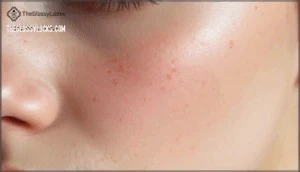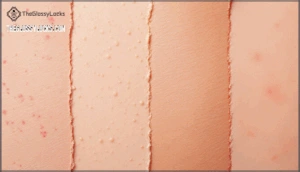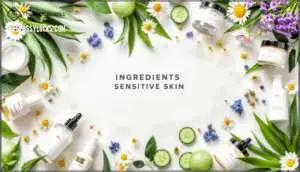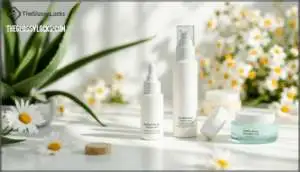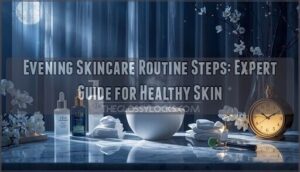This site is supported by our readers. We may earn a commission, at no cost to you, if you purchase through links.

The challenge isn’t just discomfort; it’s the frustration of watching your bathroom shelf fill with half-used products that promised relief but delivered flare-ups instead.
Whether your sensitivity stems from genetics, a compromised skin barrier, or environmental factors, understanding your skin’s specific triggers and building the right care routine can transform daily skincare from a minefield into a manageable ritual that actually soothes and protects.
Table Of Contents
Key Takeaways
- Sensitive skin affects up to 70% of women and 60% of men, causing reactions like redness, stinging, and tightness that stem from genetic factors, compromised skin barriers, environmental triggers, or underlying health conditions—and identifying your specific type (naturally sensitive, environmentally sensitive, reactive/allergic, or barrier-compromised) is essential for effective management.
- A simplified skincare routine with just three to four fragrance-free products—a gentle sulfate-free cleanser, ceramide-rich moisturizer, and mineral sunscreen—protects your barrier better than complex multi-step regimens, since layering too many products actually increases irritation risk.
- Key ingredients to seek include ceramides, niacinamide, hyaluronic acid, and aloe vera for barrier repair, while avoiding hidden fragrances, formaldehyde-releasing preservatives, and heavy metals found in 83% of pigmented cosmetics—and don’t assume "natural" or "organic" labels guarantee safety, since botanical extracts can trigger reactions just as readily as synthetic compounds.
- Environmental factors like pollution (linked to a 68% increase in sensitive skin prevalence), seasonal changes, household detergents, and even clothing fabrics continuously challenge your skin barrier, requiring proactive protection through humidifiers, hypoallergenic products, and cotton-based fabrics rather than reactive treatment after flare-ups occur.
What Does Sensitive Skin Look and Feel Like?
Sensitive skin doesn’t always announce itself the same way in everyone. Recognizing what sensitive skin actually looks and feels like is the first step toward managing it effectively. You might notice redness, tightness, or a burning sensation after using certain products, or your skin may simply feel uncomfortable without an obvious cause.
Common Signs and Symptoms
Sensitive skin doesn’t just feel different—it announces itself with a distinct set of warning signals that can range from barely noticeable tightness to full-blown flare-ups that disrupt your day. You might experience burning, itching, or stinging sensations that appear without warning. Redness triggers easily, dryness causes discomfort, and bumps explained by inflammation may dot your complexion.
Skin irritation symptoms include discoloration types ranging from pink patches to darker marks, along with peeling or scaling that leaves your face feeling raw and vulnerable.
How to Identify Easily Irritated Skin
If you’ve noticed these signals cropping up, you’re probably wondering whether your skin truly falls into the sensitive category—or if something else is going on. Skin sensitivity tests and subjective skin assessments can help clarify your irritation threshold levels.
Watch for patterns: do symptoms flare after using specific products, or do triggers like weather or stress make skin discoloration and irritation worse? Tracking these objective skin markers gives you control and helps pinpoint what’s really happening.
Sensitive Skin Vs. Other Skin Conditions
Many skin conditions share symptoms with sensitive skin, making clinical differentiation tricky. Irritation, redness, and discomfort appear in eczema, allergic contact dermatitis, and irritant contact dermatitis too. Without biomarker screening, misdiagnosis rates climb—especially since no single symptom pinpoints sensitive skin alone.
Biomarkers such as genetic markers can aid in diagnosis. Dermatologists use questionnaires, biophysical tests, and symptom overlap analysis to separate sensitivity from allergies or other dermatological conditions, reducing diagnostic challenges and improving your treatment path.
What Causes Sensitive or Irritated Skin?
Sensitive skin doesn’t just appear out of nowhere—it has specific causes that you can understand and address. Your skin’s reactivity might stem from your genetic makeup, the world around you, or even hidden health issues working beneath the surface.
Let’s break down the three main culprits behind easily irritated skin.
Genetics and Skin Barrier Weakness
Some people are simply born with skin that’s more vulnerable—their natural defenses aren’t as strong as others, thanks to genetic factors that affect the skin’s protective barrier from the start. Genetic predisposition can weaken your stratum corneum, the outermost layer that shields you from irritants.
When barrier function falters—often due to filaggrin mutations—your skin can’t hold moisture properly, leading to higher TEWL correlation values. This impaired skin barrier repair and protection leaves you more prone to dermatological conditions and constant irritation.
Environmental and Lifestyle Triggers
Even when your genetic makeup isn’t the culprit, the world around you can push your skin past its limits. Environmental factors like air pollution, seasonal changes, and cosmetic triggers account for a sharp rise in irritation and inflammation—chronic exposure to urban pollutants alone correlates with a 68% jump in sensitive skin prevalence. Pollution can also contribute to oxidative stress, damaging collagen and elastin.
Your daily habits matter too:
- Air pollution disrupts barrier function and amps up oxidative stress, especially in cities
- Cosmetic triggers like fragrance and alcohol affect 60% of sensitive skin sufferers
- Seasonal changes and low humidity can drop skin hydration by 20%
- Sleep quality and stress directly worsen irritation—over half of sensitive-skin individuals report sleep disturbances
Dietary impacts from dairy, eggs, and gluten can also spark flare-ups, while household detergents and smoking further compromise your skin’s defenses.
Underlying Health Conditions
Beyond genetics and environmental stress, certain underlying health conditions can turn your skin into a reactive minefield. Autoimmune diseases like lupus and psoriasis, inflammatory conditions such as eczema, and hormonal imbalances from thyroid disorders or hormone changes disrupt barrier integrity and heighten sensitivity. Gut health issues, chronic stress, medication side effects (especially from retinoids or antibiotics), and poor nutrition all feed the cycle of irritation—making thorough skin conditions and treatments essential.
| Condition Type | Impact on Skin |
|---|---|
| Autoimmune Diseases (lupus, psoriasis) | Trigger inflammation and barrier breakdown |
| Hormonal Imbalances (thyroid, menopause) | Alter oil production and increase dryness |
| Inflammatory Conditions (eczema, rosacea) | Weaken defenses and heighten reactivity |
| Gut Health Issues (dysbiosis, food sensitivities) | Drive systemic inflammation affecting skin |
Four Types of Sensitive Skin Explained
Not all sensitive skin is the same, and understanding your specific type helps you choose the right approach. Dermatologists usually group sensitive skin into four categories based on what’s driving the reaction.
Here’s how each type differs and what makes your skin respond the way it does.
Naturally Sensitive Skin
If you’ve ever felt like your skin protests the moment you try a new product, you might be dealing with naturally sensitive skin—a genetically wired tendency to react more intensely than others. This inherited trait often shows up early in life, with family history playing a clear role in how your skin barrier function develops and reacts to stress.
Key characteristics include:
- Genetic factors that predispose you to weakened skin barrier function from birth
- Pediatric sensitivity that often appears in childhood and persists into adulthood
- Inherited traits affecting inflammation and skin health regulation
- Heightened reactivity to natural skincare ingredients that others tolerate easily
- Ongoing need for gentle skincare products and early intervention strategies
Your best approach is understanding these inherited patterns and choosing formulas designed to support—not challenge—your skin’s natural defenses.
Environmentally Sensitive Skin
Your skin might feel perfectly fine indoors, then suddenly sting or flush the moment you step outside into cold wind or hot sun—that’s environmentally sensitive skin reacting to the world around you.
Pollution effects, weather sensitivity, and seasonal changes can all trigger irritant contact dermatitis or allergic reactions.
Even household cleaning products and climate impact from air conditioning can weaken your barrier, making irritant exposure a daily concern.
Reactive (Allergic) Sensitive Skin
Some people can slather on any cream or lotion without a second thought, but for those with reactive (allergic) sensitive skin, specific ingredients act like red flags to the immune system, triggering rashes, hives, or intense itching within hours.
Allergen identification through patch testing helps pinpoint which cosmetic ingredients cause your unique immune response, whether it’s fragrance, preservatives, or nickel.
Common culprits include:
- Fragrances that trigger allergic reactions even in fragrance-free formulas (watch for "parfum" or essential oils)
- Preservatives like methylisothiazolinone that cause delayed flare-up management challenges
- Botanical extracts marketed as "natural" but notorious for provoking irritation and irritant contact dermatitis
Knowing your triggers means you can dodge emergency treatment scenarios and build a truly safe routine.
Barrier-Compromised Sensitive Skin
When your skin’s protective lipid barrier breaks down—through over-cleansing, harsh actives, or even chronic stress—it’s like leaving your front door wide open to irritants that healthy skin would normally lock out. You’ll notice elevated TEWL (transepidermal water loss), persistent dryness, and stinging from products that never bothered you before.
Barrier repair through ceramide-rich moisturizers restores lipid balance, while calming ingredients like niacinamide support skin barrier recovery without harsh exfoliation.
Ingredients to Seek and Avoid
When you’re managing sensitive skin, the ingredients in your products matter more than the brand name on the bottle. Some compounds strengthen your barrier and calm irritation, while others trigger redness and discomfort even in small amounts.
Learning which ingredients to seek out and which to avoid gives you real control over how your skin responds.
Soothing Ingredients for Sensitive Skin
For calm, protected skin, you’ll want to reach for ingredients that work with your barrier instead of against it. Here are proven calming ingredients that dermatologists recommend:
- Ceramides rebuild your moisture barrier from the inside out
- Niacinamide reduces redness while strengthening skin tolerance
- Hyaluronic acid binds water to your skin without irritation
- Aloe vera delivers immediate cooling relief when flare-ups strike
These skin soothing ingredients help restore what sensitivity takes away.
Harmful Ingredients and Irritants
Knowing what to avoid matters just as much as what to add. Hidden Fragrances appear in countless makeup and skincare products—8.4% of women in patch tests showed allergies to common fragrance blends, with rates climbing to 14.4% after age 60. Preservative Allergens like formaldehyde-releasing agents trigger reactions even at low concentrations.
Heavy Metals including lead and titanium dioxide show up in 83% of pigmented cosmetics. Regulatory Loopholes mean approximately 88 chemicals linked to irritation remain legal in over 73,000 products.
Mixture Effects increase risk—combining irritants from soaps, laundry detergent, and cosmetics creates greater harm than single triggers alone.
How to Read Product Labels
Decoding a product label isn’t as straightforward as it should be—ingredients are listed by weight, not by risk, and the first five entries usually make up 70% of the formula. Look for fragrance-free and non-comedogenic claims backed by ingredient lists showing natural ingredients like aloe or ceramides.
Check expiration dates, scan for hidden irritants buried mid-list, and prioritize skincare product selection from brands emphasizing ethical sourcing and dermatologist testing for sensitive skin.
Essential Skincare Routine for Irritated Skin
When your skin reacts to everything, you need a routine that works with it, not against it. The right approach protects your barrier while keeping irritation at bay.
Here’s how to build a skincare plan that won’t backfire on sensitive skin.
Gentle Cleansing and Moisturizing
The foundation of managing easily irritated skin starts with two non-negotiables: a cleanser that won’t strip your barrier and a moisturizer that actually repairs it.
Choose sulfate-free cleansers that remove dirt without triggering inflammation, then follow with barrier-repair moisturizers containing ceramides to lock in hydration.
This minimalist routine promotes gentle skincare while keeping fragrance-free formulas at the center of your sensitive skin strategy.
Sun Protection for Sensitive Skin
Daily sun exposure demands vigilance—especially when your skin overreacts to everything. You need broad-spectrum sunscreen with SPF 30 or higher that shields against both UVA and UVB rays without triggering flares.
Mineral sunscreens containing zinc oxide or titanium dioxide offer gentler protection than chemical filters. Skip fragrances and known irritants like oxybenzone or PABA.
Apply generously, and reapply every two hours during outdoor activities to maintain consistent skin protection following dermatologist recommendations.
Exfoliation Tips and Precautions
Exfoliation walks a fine line—scrub too hard or too often, and you’ll strip away the protection your reactive skin desperately needs. Choose gentle chemical exfoliants like lactic acid over abrasive scrubs to minimize skin irritation.
Follow these guidelines for exfoliation for sensitive skin:
- Start slow: Once weekly maximum until tolerance builds
- Watch for redness: Stop immediately if irritation appears
- Moisturize after: Lock in hydration post-exfoliation
- Skip active days: Never combine with retinoids or vitamin C
Your barrier needs time to recover between treatments.
Simplifying Your Product Lineup
If your bathroom counter looks like a chemistry lab, it’s time to scale back—layering too many products can actually backfire on already fragile skin. A minimalist skincare routine with three to four fragrance-free products works better than a ten-step regimen.
Stick to gentle formulas that serve multiple purposes: cleanser, moisturizer, and sunscreen cover your essentials. Routine streamlining reduces ingredient layering risks while protecting sensitive skin from unnecessary exposure to potential irritants.
Practical Tips to Prevent Skin Irritation
Managing sensitive skin well means staying ahead of flare-ups before they start. You’ll want to look at factors beyond your skincare products—from the air around you to what touches your skin all day.
Here’s how to create an environment where your skin can stay calm and protected.
Managing Environmental Factors
Your skin doesn’t exist in a vacuum—it constantly reacts to the air, temperature, and irritants swirling around you every single day. Weather extremes, pollution effects, and seasonal changes all trigger irritation and environmental skin damage.
To keep your barrier intact:
- Minimize UV exposure with mineral sunscreen and protective clothing
- Use climate control wisely—humidifiers combat dry indoor air
- Shield from pollution by cleansing thoroughly after outdoor activities
Clothing, Detergents, and Household Products
What touches your skin—from the shirt on your back to the detergent in your washing machine—can either support your barrier or break it down with every wear and wash. Fabric irritation from wool or polyester, laundry detergent with harsh cleaning chemicals, and soaps with dye sensitivities all trigger sensitive skin reactions.
| Irritant Source | Product Alternatives |
|---|---|
| Laundry detergent | Fragrance-free, dye-free formulas |
| Clothing fabrics | Cotton, silk, bamboo blends |
| Household cleaners | Hypoallergenic, plant-based options |
| Fabric softeners | White vinegar or skip entirely |
Choose gentle, tested options to minimize irritation and protect your barrier.
When to Consult a Dermatologist
Sometimes home care hits a wall—and that’s when dermatology expertise becomes essential. Persistent symptoms lasting over two weeks, suspicious moles changing in size or color, OTC failure after four weeks of treatment, and diagnosis needed for unexplained redness or texture changes all warrant professional evaluation. Dermatologists recommend routine skin health checks, especially if you have risk factors like fair skin or family history of skin cancer.
- Chronic itching or rash unresolved by over-the-counter treatments signals a need for specialist care
- Sudden changes in moles—size, shape, or color—require urgent dermatological assessment
- Acne or eczema that doesn’t respond to standard products after a month needs professional intervention
- Unexplained pigmentary changes or recurring irritation may indicate underlying conditions requiring sophisticated testing
- High-risk individuals should schedule annual melanoma screenings with a board-certified dermatologist
Frequently Asked Questions (FAQs)
Can hormonal changes worsen sensitive skin reactions?
Yes, hormonal fluctuations can throw your skin for a loop. Estrogen impact during pregnancy sensitivity, menopause effects, and stress hormones all heighten skin irritation and inflammation.
These shifts compromise your barrier, triggering sensitive skin flare-ups and increased irritation responses.
How long does skin barrier recovery typically take?
Recovery timeline varies widely—usually two to twelve weeks depending on damage severity.
Consistent use of barrier-repair ingredients and gentle hydration accelerates skin barrier repair, while avoiding triggers prevents setbacks in sensitive skin recovery.
Are natural or organic products always safer?
Many assume organic certification or natural labeling guarantees gentler organic beauty products, but poison ivy is natural too.
Just because something is natural doesn’t mean it’s safe—poison ivy proves organic doesn’t equal gentle
Natural ingredients like essential oils, botanical extracts, or citrus can provoke allergic reactions in sensitive skin just as readily as synthetic compounds—greenwashing dangers often obscure this reality.
Can sensitive skin develop suddenly in adulthood?
Absolutely—adult-onset sensitivity happens more often than you’d think. Barrier changes from aging, trigger accumulation over time, lifestyle impact, and delayed reactions to products can all spark sudden skin irritation and inflammation where none existed before.
Should I patch test every new product?
Patch testing isn’t just smart—it’s essential insurance for sensitive skin. Even dermatologist-tested products can trigger irritation or allergic reactions unique to you.
Apply new products on your inner forearm for 48 hours before using them on your face.
Conclusion
Think of your skin barrier as a lock that protects everything inside—when compromised, even safe ingredients become intruders. Effective skin care for easily irritated skin isn’t about adding more products; it’s about respecting your skin’s threshold and working with its natural defenses.
Start with the essentials, introduce one product at a time, and remember that consistency beats complexity. Your skin didn’t become sensitive overnight, and healing takes patience.
When you align your routine with what your skin actually needs rather than what marketing promises, irritation transforms from constant battle into occasional blip.
- https://www.dermatologytimes.com/view/new-aveeno-report-reveals-71-of-adults-have-sensitive-skin
- https://pmc.ncbi.nlm.nih.gov/articles/PMC6533878/
- https://www.sciencedirect.com/science/article/pii/S2213398423001690
- https://www.dermalogica.com/blogs/living-skin/could-your-sensitive-skin-be-caused-by-your-environment
- https://www.futuremarketinsights.com/reports/sensitive-skin-solutions-market

